Sensitivity
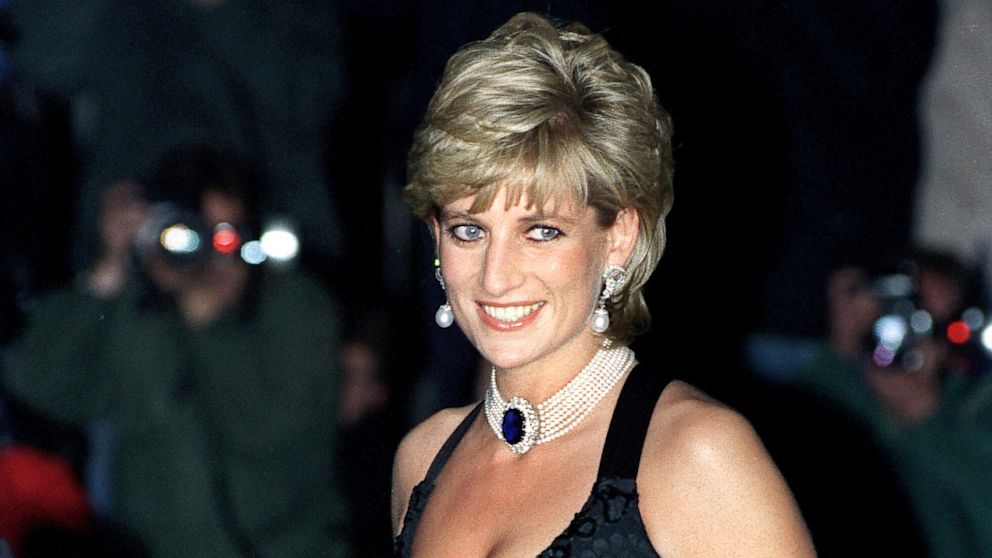
In August 1997, Diana, Princess of Wales, was killed in a car crash in the Pont de l’Alma tunnel in Paris. The worldwide story sparked international grieving and a host of conspiracy theories as to what could’ve caused the princess’s limo to collide head-on with a concrete pillar. At the time, it was believed that the fatal crash was caused by Diana’s celebrity status and the mad chase of paparazzi after the limo… the very story Disney was developing to fuel its wild trip through Hollywood.
This would not be the first nor last time that a theme park operator would be forced to censor itself in the wake of tragedy or controversy. As just a few examples show:
- In 1998, the planned February debut of Universal Studios Florida’s “Twister… Ride It Out!” was put on indefinite hold after a series of deadly tornadoes devastated the state, killing 42 people and injuring hundreds more. The idea of “surviving” a simulated tornado in a special effects attraction was suddenly not quite as charming. The attraction ended up opening three months later in May.
- After the September 11th 2001 terrorist attacks in New York City, Universal Orlando hurriedly revised its Halloween Horror Nights event, replacing red lights with green ones, changing any references to “blood” into “slime,” and recasting the event’s character icon completely; meanwhile, Disney cut references to crashed planes from the Jungle Cruise skippers’ spiel and made edits to the Lost Legend: The Timekeeper, which showed images of New York’s skyline with the Towers in tact.
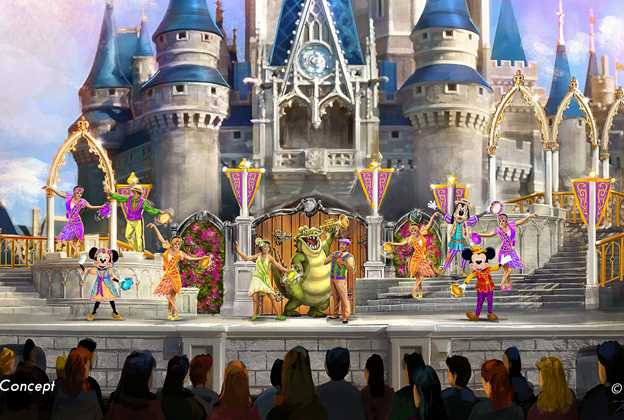
- In 2016, Disney famously removed any and all references to crocodiles or alligators from Jungle Cruise spiels, parades, and shows following the tragic death of a 2-year-old killed by an alligator along the shores of Walt Disney World’s Seven Seas Lagoon.
In a world where celebrity was just starting to take its turn toward gossip columns, Internet buzz, paparazzi stalking stars, tabloids, X-rated tapes, and reality TV, the death of Princess Diana was a reminder that celebrity can have serious consequences. Suddenly the idea of racing through town, swerving left and right to avoid paparazzi wasn’t so funny, and Disney designers were tasked with making something new.
Their first idea was simply to axe the idea of Superstar Limo altogether. If the ride couldn’t be quick and couldn’t feature paparazzi, what was the point?

Instead, they looked to Disney’s Hollywood Studios and allegedly toyed with bringing one of the Florida park’s headliners to California Adventure’s Hollywood land instead: The Great Movie Ride, The Twilight Zone Tower of Terror, or Rock ‘n’ Roller Coaster (here as Rock ‘n’ Roller Coaster Starring No Doubt, the Anaheim-born, internationally renowned rock group headed by Gwen Stefani). Each idea simply proved too expensive for the low-budget park. That meant that the idea of Superstar Limo would go ahead, just with some key limitations.
Final Draft
Faced with a concept that didn’t click anymore, executives who’d lost interest, and budgets sliding ever downward, designers went back to work on what would become the final version of Superstar Limo, and emerged with a ride starved of purpose and misaligned with the public. One step at a time, the ride crumbled.
STEP 1: A mandated shift in concept and execution.
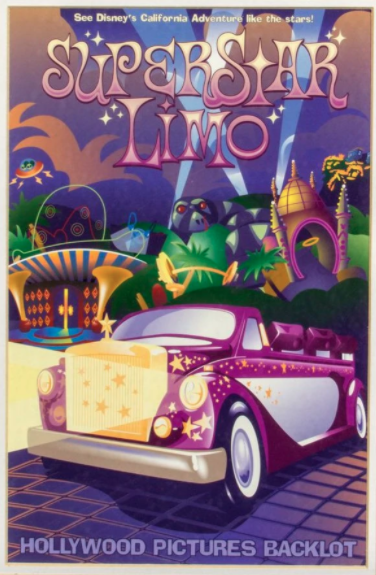
In light of Princess Diana’s tragedy, the first directive was that the paparazzi be left in the dust. They were cut from the ride, and certainly the idea of escaping them was no longer a motivating factor. (Which, again in retrospect, is probably good. We’ve largely gravitated out of the reality TV era where Paris Hilton was all the rage and we longed to be celebrities ourselves. The idea of the paparazzi is its own kind of tired, and not a great plot point for a Disney ride anyway.)
Second, the ride needed to be slowed way down. Whatever attraction Imagineers ended up designing to take the place of this wild Hollywood chase, it needed to be a scenic tour rather than an out-of-control race.
STEP 2: Budgets were slashed.
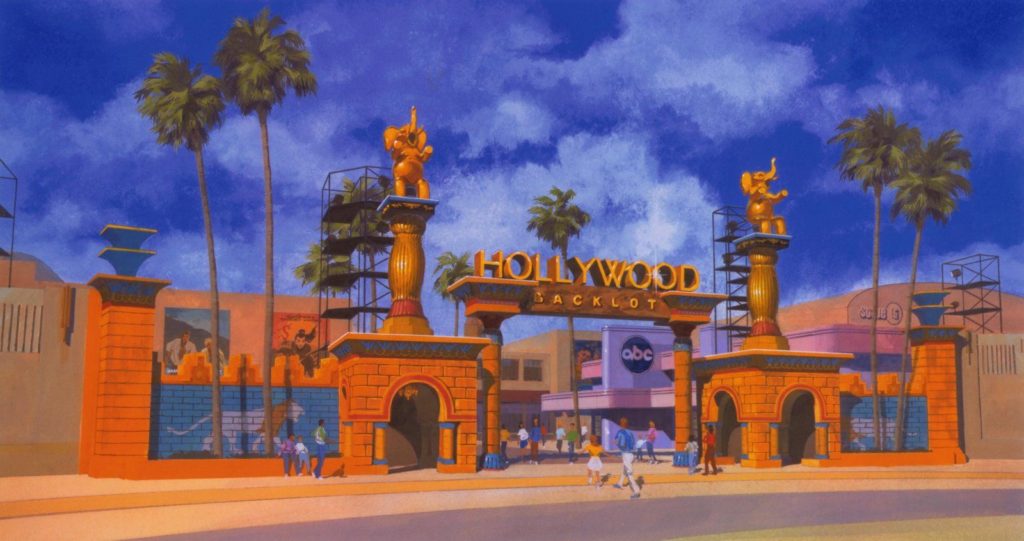
First, the Theme Building exterior to the ride had its restaurant cut. Then, the Theme Building was cut altogether. The concept of the land evolved into the Hollywood Pictures Backlot, a strange rag-tag recreation of what Hollywood would look like if it were built on a Hollywood set. Superstar Limo would be relegated to a big, tan showbuilding in a desolate corner of an industrial “studio backlot” purposefully decorated by electrical wires, rusted ductwork, and steel walls.
It wasn’t just Superstar Limo or the Hollywood Pictures Backlot. All of California Adventure was built on-the-cheap, using as many off-the-shelf rides as possible and packing the park with retail and dining to try to stage the new California Adventure as a more “cultured” park like Epcot – a plan executives thought very clever, but blew up in their face when people didn’t care for the modern, edgy “culture” the park created.
STEP 3: A major change in style and setting.
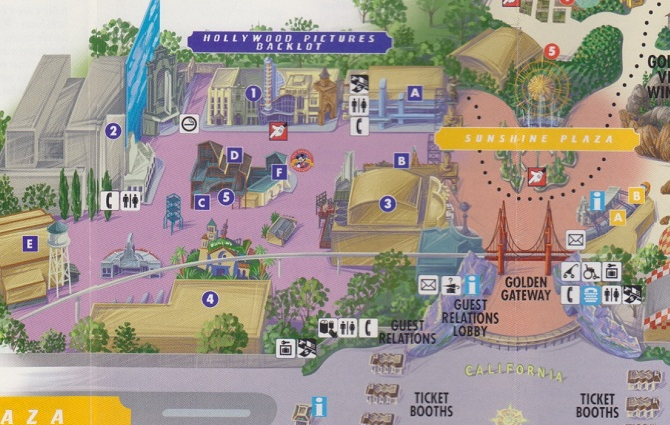
As a result, Imagineers had to go back to the drawing board entirely. A slow-moving ride not motivated by the paparazzi required a new plot and a new pace. If Mr. Toad’s Wild Ride were slowed to the speed of “it’s a small world,” it would seem downright sparse. A slow-moving ride requires a lot to look at in order to keep riders from becoming bored. So rather than one-off, broad puns and simple set-ups, this new, slow Superstar Limo would need to be an oversaturated, highly-populated world with plenty to see.
STEP 4: Eisner’s elite and executive humor.
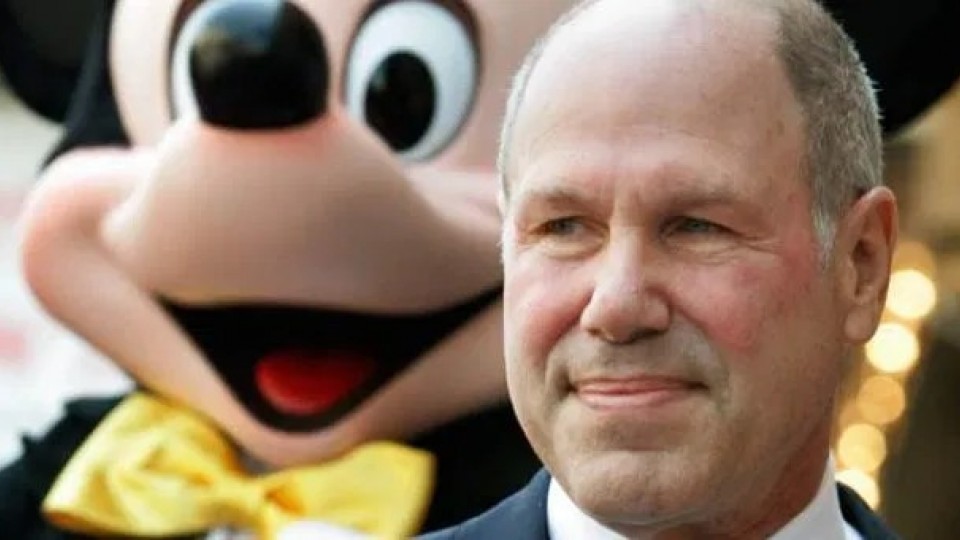
A slow moving ride without a plot or purpose wouldn’t do, so the ride was recast as a humorous tour of Los Angeles’ neighborhoods, packed with puns and jokes.
The problem is, Eisner and his cronies, in an effort to skewer celebrity, had been unwittingly clamped into it. They slowly evolved the ride into blacklight style recreations of Los Angeles’s cliquey neighborhoods and swanky gated communities, packed with puns that only Hollywood’s elite would care to understand. In the Malibu / Muscle Beach scene on the ride, eagle-eyes guests would notice the hills of Malibu plagued by both fires and mudslides at once – the sort of “in-joke” that must’ve earned self-important chuckles from Eisner and his Hollywood elite friends, but meant very little to a family from Akron, Ohio or even Buena Park.
STEP 5: Pack the ride with all the “celebrities” you don’t have to pay for.
And a slow-moving tour through Hollywood with lots to see meant that these new cartoon-style streetscapes needed people.
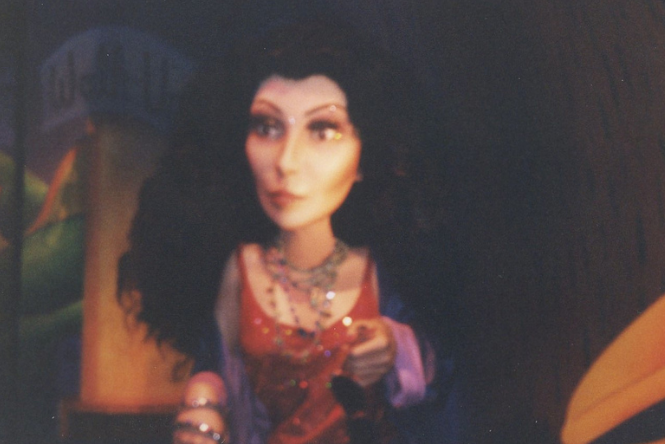
But as the budget took a nose-dive and Eisner lost interest in his pet project, it was decided that Superstar Limo needed modern celebrities. But with a budget slashed and no new funds available to get them on board, designers were tasked with finding celebrities that Disney already worked with who would graciously allow their likenesses to be used on-board.
They managed to collect a cadre of “stars” (C-list or below, in 2001 terms) that could be created in cartoon, comic book, and waist-high style. More than mannequins but far from animatronics, this new cast would take up residence among the unusual ride’s odd sets.
Who? Well, we’re getting there. It’s time now to step inside and take a ride through Superstar Limo to relive what might be Disney’s most pointless and embarrassing ride ever.
Superstar Limo
The experience of Superstar Limo begins long before you’ve stepped onto the ride. Tucked away into the corner of Hollywood Pictures Backlot’s industrial backlot area, the ride’s exterior is certainly a far cry from the grand recreation of the Theme Building once imagined. Instead, it’s a series of flat cutouts layered on top of one another, representing the neighborhoods and features of Los Angeles.

The easy-to-ignore exterior is actually packed with some fun details, as chronicled by a Yesterland article on the facade. It may not help you to understand that on this ride, you should be pretending to be a newly-minted movie star, but at least it’s better than a big, boxy showbuilding. Around the corner, you step into “Baggage Claim” inside LAX where the television monitors are alight with breaking news from a rather odd, latex puppet-version of Joan Rivers, who’s eagerly awaiting the arrival of Hollywood’s brightest new star, who’s apparently just landed! (Pst, that’s you.) You can watch the entire queue experience (and hear some of the very unusual PA announcements made in the “terminal” here.
Passing through the terminal’s advertisements for taxi services and gift shops, you find that your ride is a little more elite: A deluxe cartoon-proportioned limousine with a yellow star emblem on the hood. A Cast Member in a luxurious red valet outfit gestures you onboard and tells you to “Enjoy your premiere.”
As the limo advances slowly toward a highway on-ramp, a light-up traffic sign signals that “All freeways are jammed,” so the limo makes a right and heads for a tunnel. That’s when you receive a collect call from your agent – a similarly frightening latex puppet head. He welcomes you to Hollywood and tells you to get to the Chinese Theater pronto.
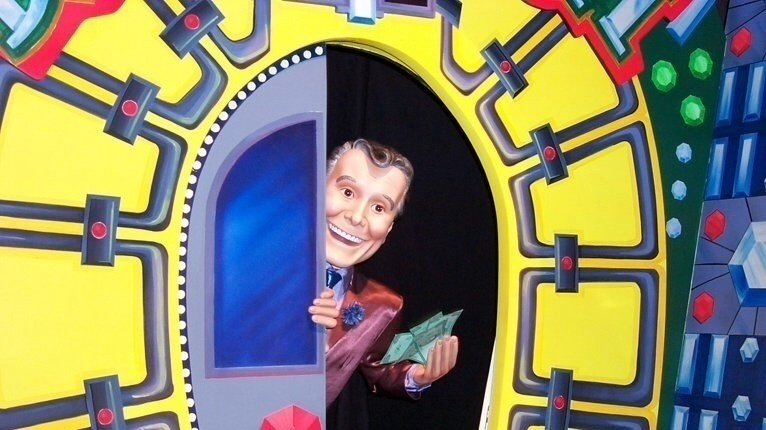
First stop? “Glamorous Rodeo Drive” and the ornate, cartoon-proportioned exterior of “The Bauble Room” is dead ahead (Ha! Get it? Because of the Bubble Room, the ultra-exclusive LA club. Oh… You didn’t get the reference? “I guess you had to be there,” Eisner would likely say). As the door swings open, a Regis Philbin mannequin leans out, waving cash at you as your limo “driver” narrator makes a timely reference to Who Wants To Be A Millionaire? Continuing along, you’ll see “vivacious Melanie Griffith and dashing Antonio Banderas” who lift their glasses to you as you pass shops like “Law Suits” and “Fur Sure.” And there standing outside Dollars Scents is “Hollywood beauty Cindy Crawford.”
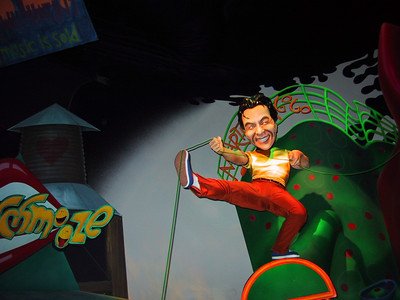
Next, you drive to the Sunset Strip for a close encounter with Tim Allen and Jackie Chan. At this point, you’re probably thinking this ride is pretty dark for a blacklight ride, painted almost entirely in deep greens and dull oranges. It’s certainly not very pretty. Maybe the idea was to make it look like a neon lit streetscape at night?
The next scene, the Bel Air room, features Drew Carey sitting in a lawnchair under an umbrella and selling maps to the homes of the stars.
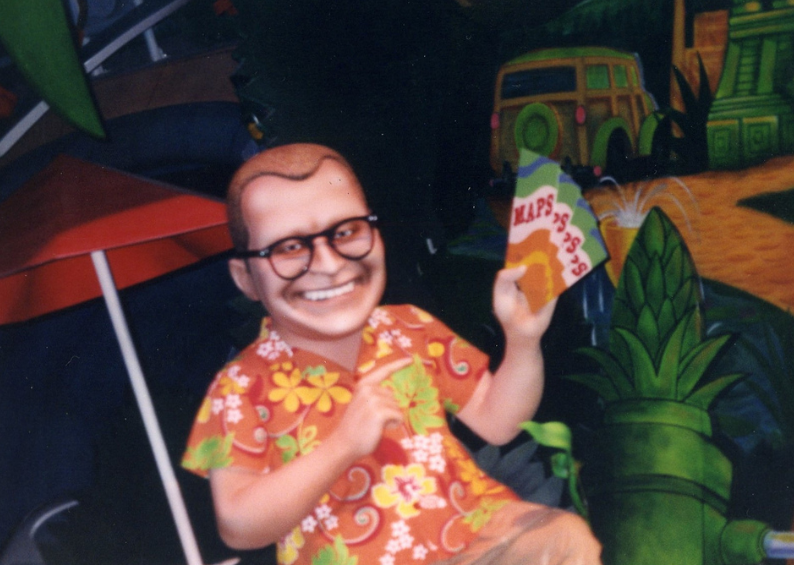
Cher’s hanging out in a busy Malibu room that sends you into a tattoo parlor and then to the streets of Hollywood where your adoring fans ask for your autograph via flat cutouts. As cameras flash, you arrive at the premier of your movie and a comic-book style Chinese Theater where you’re ready for your last celebrity encounter: the big finale.
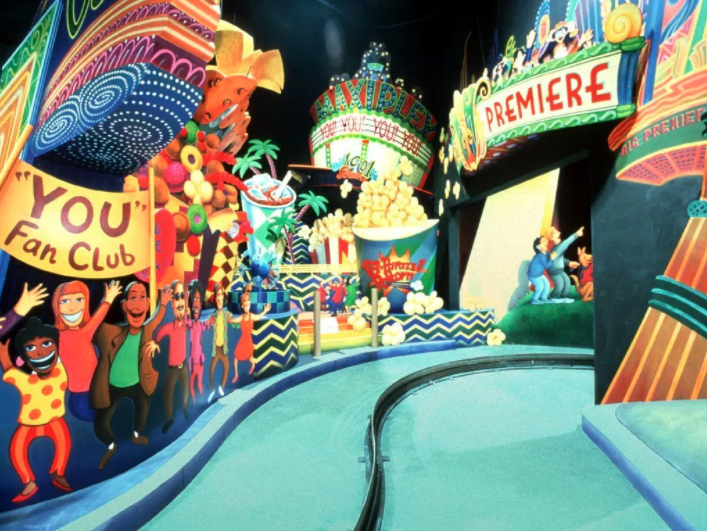
Whoopi Goldberg! “You’re a sensation! And you know what that means, baby – you’ve arrived!” With your photo plastered across a giant overhead billboard, you truly are a star.
And… there you go.
You can watch the complete experience from queue to exit here, or relieve your glamorous experience in this rare on-board video:
What did you think? Does Superstar Limo rank among Disney’s best dark rides? Certainly not. It shouldn’t even be in the same sentence as Pirates of the Caribbean or Haunted Mansion. It wasn’t supposed to be on their level, though, so what about Alice in Wonderland or Snow White’s Scary Adventures? Not even close. There’s no plot, no lovable characters, no emotion, and it’s not even fun to look at.
So maybe newer, C-Ticket rides like Roger Rabbit’s Car Toon Spin or Finding Nemo’s Submarine Voyage? Sorry. Not even close.
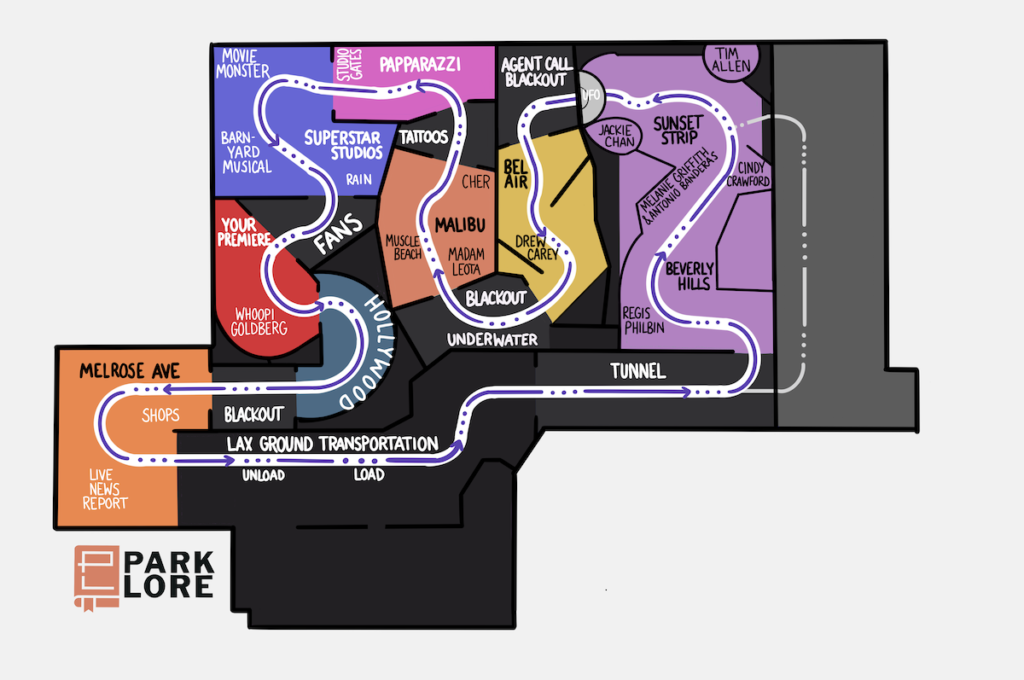
Superstar Limo is, in a word, bad. It’s not fun, or charming, or interesting, or compelling, and it’s doubtful you’d care to go on it again. And for a park struggling to get half of its expected attendence, that’s not a good thing.
What could be done about Superstar Limo? We’re about to dissect its issues and get to the bottom of this before finding out how Disney fixed the ride for good.


